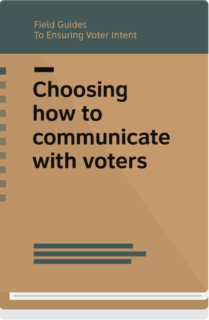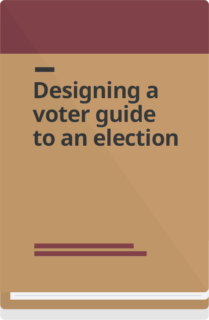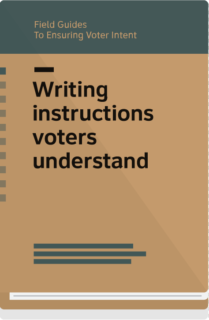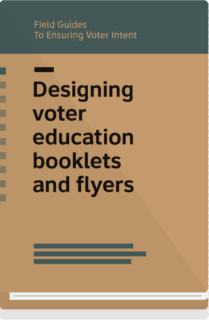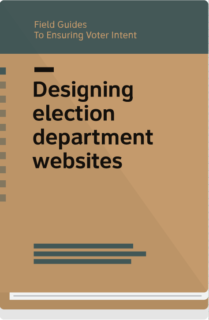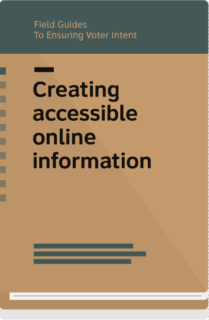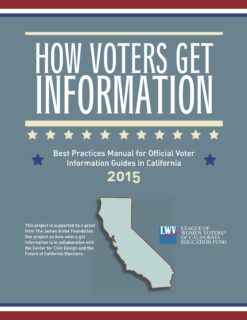Voter education
Voters experience elections in a radically different way from how elections administrators experience elections. Where election administrators see a linear path from registering, to learning about the ballot, to voting, voters are more likely to jump around. At every stage, they are deciding whether or not to take the next step in the voting process.
That makes every interaction between an elections office and a voter crucial. Here are our tips for creating welcoming voter education materials that invite voters to participate no matter what stage of the voting process they begin at.
Treat all communication as a conversation
That looks like:
- Being polite, personable, and positive — just like you are in person
- Using personal pronouns, like “you” and “we”
- Using the same voice across all media
Read more about crafting an approachable tone of voice in our article What’s the conversation you’re having with voters?
Anticipate and answer voters’ questions
Great voter education anticipates voters’ questions and proactively answers them.
Those of us who work in elections think about voting as a process. You register to vote, and then figure out your options for taking part, then do your homework about who the candidates are and what’s on the ballot. Then you vote.
But many voters start with the ballot. What’s on the ballot? Is there something that affects me? If there is, what are my options for voting?
Read our article Answering voters’ questions: what’s on the ballot, and the mechanics of voting
Get to know The epic journey of American voters
Know your audience
Different voters have different needs and questions. CCD has done research on some voting populations, but this isn’t a complete list. Get to know your community members, and make a plan to preemptively answer their questions in your voter education materials.
Accessibility
- See our Accessibility skill page
- Use AccessibleVoting.net as an example of what kind of information voters with disabilities are looking for as they prepare to vote
Justice involved
- Read our report Voting rights after prison: The information barriers to voting after a felony. It includes examples of website pages explaining restoration of voting rights.
Language access
- See our Language Access running elections page which contains information about starting and expanding language access to voters.
New citizens
- Read stories from new citizens. There are 11 million naturalized U.S. citizens who are eligible to vote but aren’t. Our research looks at why.
Tools
Civic icons and images
Visuals to enhance your website, voter guides, posters, mailers, and more.
Choosing how to communicate with voters
Election officials have more ways to communicate with voters than ever before, from traditional printed booklets, to the web, radio and…
Designing a voter guide to an election
In many jurisdictions, election officials send a booklet to registered voters with information about what’s on their ballot and how…
Pocket voter guide template
A template for printed voter education materials covering 8 bite-sized topics.
Writing instructions voters understand
It’s amazing the difference simple language can make for voters. In research conducted for the U.S. National Institute of Standards and Technology (NIST),…
Designing voter education booklets and flyers
With each election, voters receive flyers and booklets to help them understand the election process, register, find their polling places, and learn what’s…
Designing election department websites
Voters increasingly rely on online sources for information about where to vote, what’s on the ballot, and when they can vote. But…
Creating accessible online information
The people who come to your website have a wide range of needs. When we talk about making websites and…
Voter education subtopics
Emails and text messages
Whether you’re writing an email or a text message, keep the writing short and concise. Subject lines worked best when they emphasized deadlines and gave voters a reason to take action.
If you find yourself answering the same questions, consider setting up an email autoresponse.
We’ve put together some text, ready for you to customize, including alternative messages to use as deadlines pass. Download the Microsoft Word file to get started.
Pocket guides

Even in the digital age, paper voter guides are an effective tool for informing the public.
With just 1 sheet of letter-sized paper, you can create a pocket-sized booklet with 8 pages. We recommend using each page to give a bite-sized amount of information about a single topic. Our template can be easily adapted to meet your jurisdiction’s needs.
ElectionTools: Pocket voter guide template
We also have templates available for download in Spanish, Chinese, and Arabic
Results

Voters typically expect to find out the outcome of an election the same day. But that’s not always possible. Election offices can take steps to communicate the partial or incomplete results clearly with voters in a way that prevents premature conclusions and misinformation about winners. Striking a calming tone, keeping key information simple and consistent, and reinforcing the security of our elections are a few effective ways to start.
Read our recommendations for What to do about results: set expectations with explanations
Voter guides
An official guide to an election provides accurate information that voters need and can impact how confidently they participate in an election. You’ll find resources here on how to create a guide, with everything from templates, color palettes, recommended fonts and information to consider including.
Workbook: Designing a voter guide to an election
Before and after examples of voter guide design work
Websites
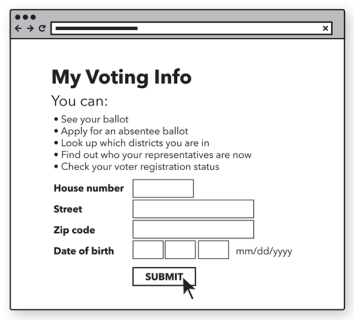
Voters start the voter journey with the ballot. Communicating the information they are looking for on an election website will result in better informed voters. Learn the common questions voters that should be clearly answered on an election website.
Our work
Project: AccessibleVoting.net (2022)
Research shows that access to clear, timely information can make the difference between voters exercising their right to vote or not participating in elections. To close this voter gap, we launched AccessibleVoting.net a new nationwide index of accessible voting options in every state. Every voter in the US has the right to cast their ballot privately and independently, but too often, we’ve seen this reality fall short. We worked with Microsoft and Coforma.io to create this resource after hearing from many voters with disabilities about how difficult it can be to dig through states’ websites to find the essential information they need on accessible voting.
Website: AccessibleVoting.net
Article: We launched a user-friendly website with accessible voting options in every state
Research: Voting rights after prison: The information barriers to voting after a felony and see examples of website pages explaining restoration of voting rights (2020)
This research project explored how easy it is for people leaving prison to determine whether they are eligible to vote and how to register. Navigating the complex process of getting voting rights after prison can often be a barrier to voting. Our research found that even after restoring voting rights, missing or hard to understand information on election websites can also be a barrier to voting.
Report: Voting rights after prison: The information barriers to voting after a felony
Project: Healthy Voting (2020)
To address the uncertainty about in-person voting following the COVID-19 crisis, CCD joined a group of organizations to create HealthyVoting.org, a resource with advice from public health experts and up-to-date information about voting options and rules. The website has information about voting rules for the election in all 50 states, the District of Columbia, voting for Americans Abroad, and the five territories. Our goal was to lay out the options to help voters make the best decision for themselves.
Website: HealthyVoting.org
Article: Helping voters make healthy choices
Research: Short stories from new citizens (2019)
There are about 11 million naturalized American citizens who are eligible to vote but not voting. Our research and interviews focused on the obstacles they face in taking part in civic life. As we listened to their stories about how they came to the U.S., what they were looking for, how they made lives for themselves and their families, we learned that acculturation is as important as translations, including levels of civic literacy that natural-born citizens often don’t think of. Our report contains the barriers naturalized citizens faced to confidently voting.
Report: Short stories from new citizens
Project: California Voter Guide (2016)
Our research for the Future of California Elections explored how voters (including new voters, registered non-voters and potential voters) find information about elections, and what works — and doesn’t work — about their current sources. We learned voters need information that helps them bridge civic literacy gaps in words they understand.
We worked with election departments in California to update voter guides with the best practice recommendations for the 2016 elections. These resources can help election departments who want to update their voter guides.
Project: Voter guides and other voter information
Project: A voter bill of rights in plain language for California (2016)
Our research on how voters get information about elections showed us just how many people have trouble finding what they are looking for. We worked with our partners at the League of Women Voters of California Education Fund to create a manual of best practices for official voter guides and a series of webinars. The project was referenced in a hearing on election in March 2015 and the California Senate committee then approved a bill to ensure election information is written in plain, accessible and easily understandable language.
Research: Informed voters from start to finish: Voter research and usability testing (2016)
We partnered with e.thePeople and TurboVote to connect voters with voter guides. The project started with usability testing to improve messages to voters. Then we followed a group of 52 voters from around the country for the month around the General Election to understand what type of messages they wanted as they prepared to vote. We focused on 4 aspects of the messages: the style and tone of the messages, the subject line, how the links to the voter guides are presented, and the timing of the messages.
Project: Messages and notices to help voters be well informed
Report: Informed Voters from Start to Finish: Voter research and usability testing
Research: Voters in minority counties less likely to find answers on local election websites (2013)
We looked at the home pages of election websites for 147 counties and found that majority-minority counties’ election websites consistently had fewer keywords that would help voters find answers. This included words like “ballot” and “vote-by-mail.”
Report: Voters in minority counties less likely to find answers on local election websites
Research: Communicating with voters: Research into what works in voter education brochures and flyers (2013)
This research project explored how well a sample of booklets and flyers explain US election concepts and procedures to new voters (including young adults, immigrants, and voters with lower literacy or who speak English as a second language). We learned that voters wanted answers to their basic questions, complete information presented in a clear way, information about how to mark their ballot, and details like dates, addresses and contact information that help them take action.
Report: Communicating with Voters: Research into what works in voter education brochures and flyers



